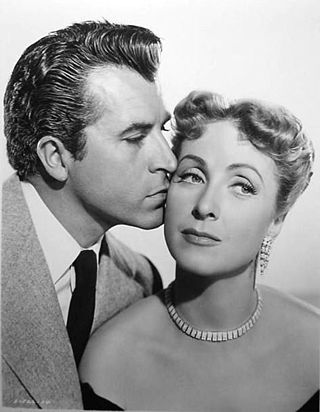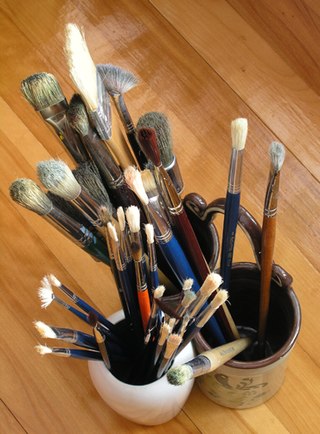
Hair is a protein filament that grows from follicles found in the dermis. Hair is one of the defining characteristics of mammals. The human body, apart from areas of glabrous skin, is covered in follicles which produce thick terminal and fine vellus hair. Most common interest in hair is focused on hair growth, hair types, and hair care, but hair is also an important biomaterial primarily composed of protein, notably alpha-keratin.

A hairstyle, hairdo, haircut or coiffure refers to the styling of hair, usually on the human head but sometimes on the face or body. The fashioning of hair can be considered an aspect of personal grooming, fashion, and cosmetics, although practical, cultural, and popular considerations also influence some hairstyles.

A buzz cut, or wiffle cut, is a variety of short hairstyles, especially where the length of hair is the same on all parts of the head. Rising to prominence initially with the advent of manual hair clippers, buzz cuts became increasingly popular in places where strict grooming conventions applied. In several nations, buzz cuts are often given to new recruits in the armed forces or newly incarcerated inmates. However, buzz cuts are also used for stylistic reasons.

A bob cut, also known as a bob, is a short to medium length haircut, in which the hair is typically cut straight around the head at approximately jaw level, and no longer than shoulder-length, often with a fringe at the front. The standard bob cut exposes the back of the neck and keeps all of the hair well above the shoulders.

The high and tight is a military variant of the crew cut. It is a very short hairstyle, characterized by the back and sides of the head being shaved to the skin and the option for the top to be blended or faded into slightly longer hair. It is most commonly worn by men in the U.S. armed forces. It is also popular with law enforcement officers and other public safety personnel. Although "high and tight" is the primary term used in military and law enforcement, the same haircut is sometimes referred to by civilians as a "walker".

A crew cut is a type of haircut in which the upright hair on the top of the head is cut relatively short, graduated in length from the longest hair that forms a short pomp (pompadour) at the front hairline to the shortest at the back of the crown so that in side profile, the outline of the top hair approaches the horizontal. Relative to the front view, and to varying degrees, the outline of the top hair can be arched or flattened at the short pomp front and rounded or flattened over the rest of the top to complement the front hairline, head shape, face shape and facial features. The hair on the sides and back of the head is usually tapered short, semi-short, or medium.

A French braid, also called a French plait, is a type of braided hairstyle. The three-strand gathered plait includes three sections of hair that are braided together from the crown of the head to the nape of the neck.

A flattop is a classic hairstyle characterized by short hair on the sides and back of the head, with the top hair cut short and styled to stand upright in a flat, level plane.

Hair fetishism, also known as hair partialism and trichophilia, is a partialism in which a person sees hair – most commonly, head hair – as particularly erotic and sexually arousing. Arousal may occur from seeing or touching hair, whether head hair, armpit hair, chest hair or fur. Head-hair arousal may come from seeing or touching very long or short hair, wet hair, certain colors of hair or a particular hairstyle.
Artificial hair integrations, more commonly known as hair extensions, hair weaves, and fake hair add length and fullness to human hair. Hair extensions are usually clipped, glued, or sewn on natural hair by incorporating additional human or synthetic hair. These methods include tape-in extensions, clip-in or clip-on extensions, micro/nano rings, fusion method, weaving method, and wigs.

An eponymous hairstyle is a particular hairstyle that has become fashionable during a certain period of time through its association with a prominent individual.

The wings haircut, also known the Mod haircut, Mop top, flippies, flow, Justin Bieber haircut, or skater hair is a popular hairstyle used in the skateboarding, surfer, mod, and preppy community. Typically long, the style can range from long and drooping below the eyes, to a shorter length. The haircut is typically wavy and, if straight, the length comes to halfway down the ears. Instead of lying on the wearer's ears, the hair flips up and comes straight out like an airplane wing, hence the name. The hairstyle was popular among men in the 1960s, 1970s, mid-late 2000s, early 2010s and 2020s.

Bangs or a fringe are strands or locks of hair that fall over the scalp's front hairline to cover the forehead, usually just above the eyebrows, though can range to various lengths. While most people cut their bangs straight, they may also shape them in an arc or leave them ragged.

Long hair is a hairstyle where the head hair is allowed to grow to a considerable length. Exactly what constitutes long hair can change from culture to culture, or even within cultures. For example, a woman with chin-length hair in some cultures may be said to have short hair, while a man with the same length of hair in some of the same cultures would be said to have long hair.

The pompadour is a hairstyle named after Madame de Pompadour (1721–1764), a mistress of King Louis XV of France. Although there are numerous variations of the style for men, women, and children, the basic concept is having a large volume of hair swept upwards from the face and worn high over the forehead, and sometimes upswept around the sides and back as well.
The undercut is a hairstyle that was fashionable from the 1910s to the 1940s, predominantly among men, and saw a steadily growing revival in the 1980s before becoming fully fashionable again in the 2010s. Typically, the hair on the top of the head is long and is often parted on either the side or center, while the back and sides are buzzed very short. It is closely related to the curtained hair of the mid-to-late 1990s, although those with undercuts during the 2010s tended to slick back the bangs away from the face.

Hairstyles in the 1980s included the mullet, tall mohawk hairstyles, jheri curls, flattops, and hi-top fades, which became popular styles. Amongst women, large hair-dos, puffed-up styles, permanent waves, and softer cuts typified the decade. Big hair that was "often permed to achieve the desired volume" is especially associated with women of the mid 1980s as well as male rockstars of that era, especially of the glam metal genre. Television shows such as Dynasty helped popularize the high volume bouffant and glamorous image associated with it.

In the Western world, the 1950s were a decade known for experimentation with new styles and culture. Following World War II and the austerity years of the post-war period, the 1950s were a time of comparative prosperity, which influenced fashion and the concept of glamour. Hairstylists invented new hairstyles for wealthy patrons. Influential hairstylists of the period include Sydney Guilaroff, Alexandre of Paris and Raymond Bessone, who took French hair fashion to Hollywood, New York and London, popularising the pickle cut, the pixie cut and bouffant hairstyles.

A regular haircut, in Western fashion, is a men's and boys' hairstyle that has hair long enough to comb on top, a defined or deconstructed side part, and a short, semi-short, medium, long, or extra long back and sides. The style is also known by other names including taper cut, regular taper cut, side-part and standard haircut; as well as short back and sides, business-man cut and professional cut, subject to varying national, regional, and local interpretations of the specific taper for the back and sides.

A paintbrush is a brush used to apply paint or ink. A paintbrush is usually made by clamping bristles to a handle with a ferrule. They are available in various sizes, shapes, and materials. Thicker ones are used for filling in, and thinner ones are used for details. They may be subdivided into decorators' brushes used for painting and decorating and artists' brushes use for visual art.


















